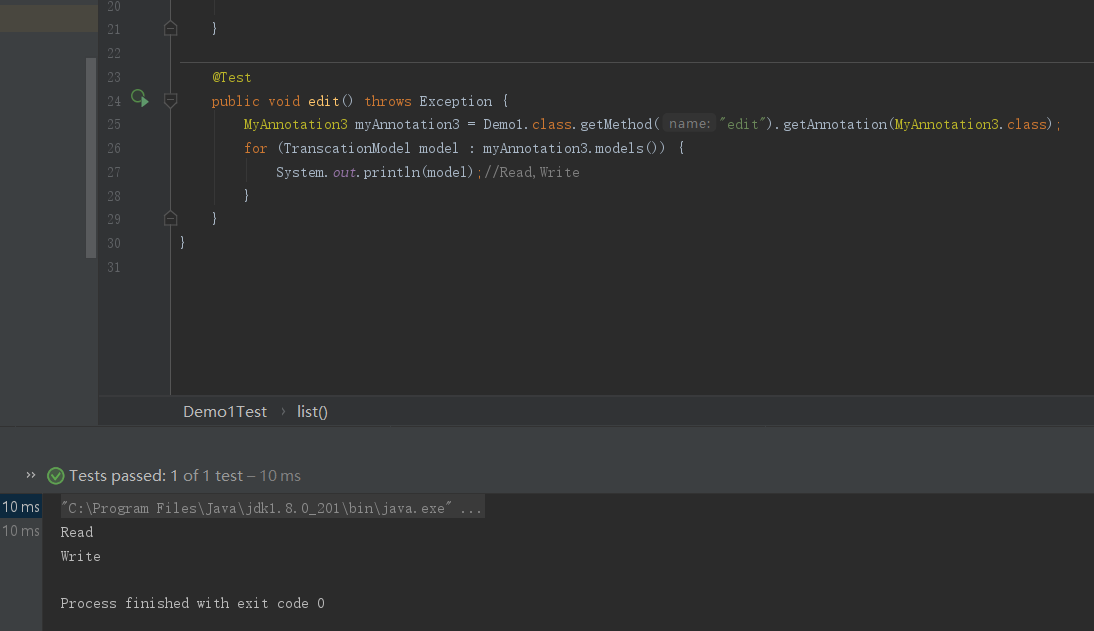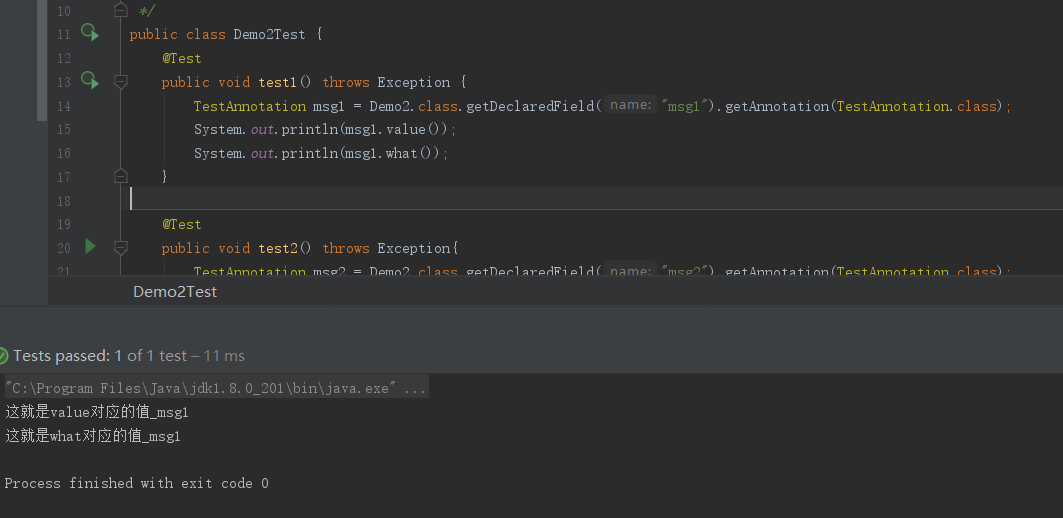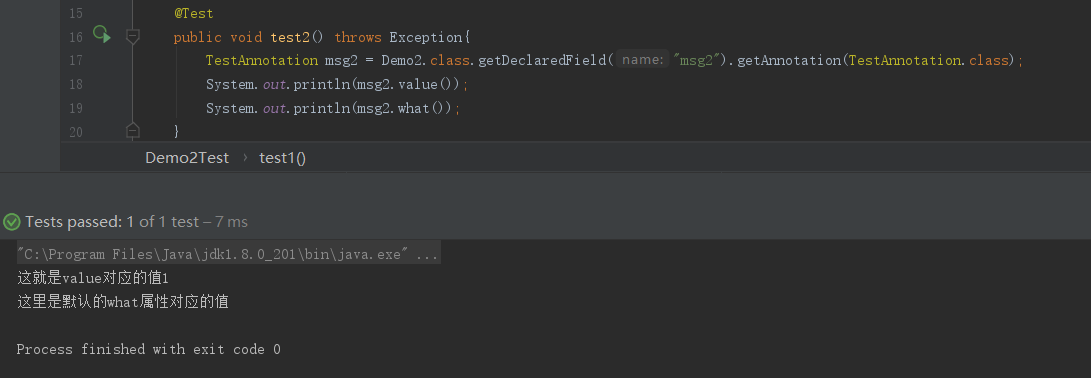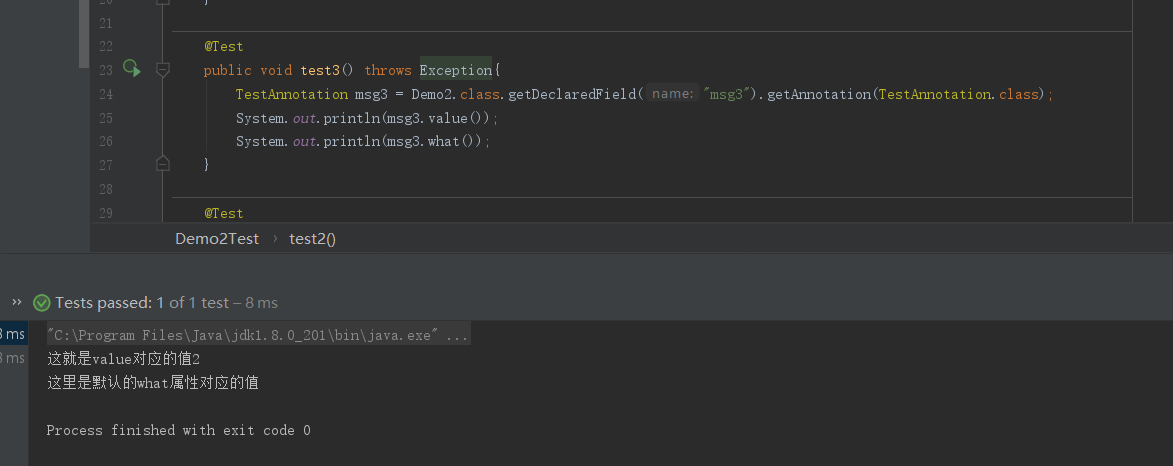1. Java注解(Annotation)
Java注解是附加在代码中的一些元信息,用于一些工具在编译、
运行时进行解析和使用,起到说明、配置的功能。
注解相关类都包含在java.lang.annotation包中。
2. Java注解分类
2.1 JDK基本注解
2.2 JDK元注解
2.3 自定义注解
3. JDK基本注解
3.1 @Override
重写
3.2 @Deprecated
已过时
3.3 @SuppressWarnings(value = "unchecked")
压制编辑器警告
Java元注解
作用:元注解用于修饰其他的注解
@Retention:定义注解的保留策略
@Retention(RetentionPolicy.SOURCE) //注解仅存在于源码中,在class字节码文件中不包含
@Retention(RetentionPolicy.CLASS) //默认的保留策略,注解会在class字节码文件中存在,但运行时无法获得,
@Retention(RetentionPolicy.RUNTIME) //注解会在class字节码文件中存在,在运行时可以通过反射获取到
@Target:指定被修饰的Annotation可以放置的位置(被修饰的目标)
@Target(ElementType.TYPE) //接口、类
@Target(ElementType.FIELD) //属性
@Target(ElementType.METHOD) //方法
@Target(ElementType.PARAMETER) //方法参数
@Target(ElementType.CONSTRUCTOR) //构造函数
@Target(ElementType.LOCAL_VARIABLE) //局部变量
@Target(ElementType.ANNOTATION_TYPE) //注解
@Target(ElementType.PACKAGE) //包
注:可以指定多个位置,例如:
@Target({ElementType.METHOD, ElementType.TYPE}),也就是此注解可以在方法和类上面使用
@Inherited:指定被修饰的Annotation将具有继承性
@Documented:指定被修饰的该Annotation可以被javadoc工具提取成文档.
自定义注解
注解分类(根据Annotation是否包含成员变量,可以把Annotation分为两类):
标记Annotation:
没有成员变量的Annotation; 这种Annotation仅利用自身的存在与否来提供信息
元数据Annotation:
包含成员变量的Annotation; 它们可以接受(和提供)更多的元数据;
如何自定义注解?
使用@interface关键字, 其定义过程与定义接口非常类似, 需要注意的是:
Annotation的成员变量在Annotation定义中是以无参的方法形式来声明的, 其方法名和返回值类型定义了该成员变量的名字和类型,
而且我们还可以使用default关键字为这个成员变量设定默认值;
注意:只有名字为“value”属性,赋值时可以省略属性名
案例一(获取类与方法上的注解值)
package com.ssm.yuan.p1; public enum TranscationModel { Read, Write, ReadWrite }
1 package com.ssm.yuan.p1; 2 3 import java.lang.annotation.*; 4 5 /** 6 * 7 * MyAnnotation3注解可以用在方法上 8 * 注解运行期也保留 9 * 可继承 10 */ 11 @Target(ElementType.METHOD) 12 @Retention(RetentionPolicy.RUNTIME) 13 @Inherited 14 @Documented 15 public @interface MyAnnotation3 { 16 TranscationModel[] models() default TranscationModel.ReadWrite; 17 }
1 package com.ssm.yuan.p1; 2 3 import java.lang.annotation.*; 4 5 /** 6 * 7 * MyAnnotation2注解可以用在方法上 8 * 注解运行期也保留 9 * 不可继承 10 */ 11 @Target(ElementType.METHOD) 12 @Retention(RetentionPolicy.RUNTIME) 13 @Documented 14 public @interface MyAnnotation2 { 15 TranscationModel model() default TranscationModel.ReadWrite; 16 }
1 package com.ssm.yuan.p1; 2 3 import java.lang.annotation.*; 4 5 /** 6 * 7 * MyAnnotation1注解可以用在类、接口、属性、方法上 8 * 注解运行期也保留 9 * 不可继承 10 */ 11 @Target({ElementType.TYPE, ElementType.FIELD,ElementType.METHOD}) 12 @Retention(RetentionPolicy.RUNTIME) 13 @Documented 14 public @interface MyAnnotation1 { 15 String name(); 16 }
1 package com.ssm.yuan.p1; 2 3 import org.junit.Test; 4 5 /** 6 * 7 */ 8 public class Demo1Test { 9 @Test 10 public void list() throws Exception { 11 // 获取类上的注解 12 MyAnnotation1 annotation1 = Demo1.class.getAnnotation(MyAnnotation1.class); 13 System.out.println(annotation1.name());//abc 14 15 // 获取方法上的注解 16 MyAnnotation2 myAnnotation2 = Demo1.class.getMethod("list").getAnnotation(MyAnnotation2.class); 17 System.out.println(myAnnotation2.model());//Read 18 19 20 21 } 22 23 @Test 24 public void edit() throws Exception { 25 MyAnnotation3 myAnnotation3 = Demo1.class.getMethod("edit").getAnnotation(MyAnnotation3.class); 26 for (TranscationModel model : myAnnotation3.models()) { 27 System.out.println(model);//Read,Write 28 } 29 } 30 }
1 package com.ssm.yuan.p1; 2 3 /** 4 * 5 * 获取类与方法上的注解值 6 */ 7 @MyAnnotation1(name = "abc") 8 public class Demo1 { 9 10 @MyAnnotation1(name = "xyz") 11 private Integer age; 12 13 @MyAnnotation2(model = TranscationModel.Read) 14 public void list() { 15 System.out.println("list"); 16 } 17 18 @MyAnnotation3(models = {TranscationModel.Read, TranscationModel.Write}) 19 public void edit() { 20 System.out.println("edit"); 21 } 22 }
案例一测试结果


案例二(获取类属性上的注解属性值)
1 package com.ssm.yuan.p2; 2 3 import java.lang.annotation.ElementType; 4 import java.lang.annotation.Retention; 5 import java.lang.annotation.RetentionPolicy; 6 import java.lang.annotation.Target; 7 8 /** 9 */ 10 //@Retention(RetentionPolicy.SOURCE) 11 @Retention(RetentionPolicy.RUNTIME) 12 @Target(ElementType.FIELD) 13 public @interface TestAnnotation { 14 String value() default "默认value值"; 15 16 String what() default "这里是默认的what属性对应的值"; 17 }
1 package com.ssm.yuan.p2; 2 3 /** 4 * 5 * 获取类属性上的注解属性值 6 */ 7 public class Demo2 { 8 @TestAnnotation(value = "这就是value对应的值_msg1", what = "这就是what对应的值_msg1") 9 private static String msg1; 10 11 @TestAnnotation("这就是value对应的值1") 12 private static String msg2; 13 14 @TestAnnotation(value = "这就是value对应的值2") 15 private static String msg3; 16 17 @TestAnnotation(what = "这就是what对应的值") 18 private static String msg4; 19 }
1 package com.ssm.yuan.p2; 2 3 import org.junit.Test; 4 5 /** 6 */ 7 public class Demo2Test { 8 @Test 9 public void test1() throws Exception { 10 TestAnnotation msg1 = Demo2.class.getDeclaredField("msg1").getAnnotation(TestAnnotation.class); 11 System.out.println(msg1.value()); 12 System.out.println(msg1.what()); 13 } 14 15 @Test 16 public void test2() throws Exception{ 17 TestAnnotation msg2 = Demo2.class.getDeclaredField("msg2").getAnnotation(TestAnnotation.class); 18 System.out.println(msg2.value()); 19 System.out.println(msg2.what()); 20 } 21 22 @Test 23 public void test3() throws Exception{ 24 TestAnnotation msg3 = Demo2.class.getDeclaredField("msg3").getAnnotation(TestAnnotation.class); 25 System.out.println(msg3.value()); 26 System.out.println(msg3.what()); 27 } 28 29 @Test 30 public void test4() throws Exception{ 31 TestAnnotation msg4 = Demo2.class.getDeclaredField("msg4").getAnnotation(TestAnnotation.class); 32 System.out.println(msg4.value()); 33 System.out.println(msg4.what()); 34 } 35 }


案例三(获取参数修饰注解对应的属性值)
1 package com.ssm.yuan.p3; 2 3 import java.lang.annotation.*; 4 5 /** 6 * 7 * 非空注解:使用在方法的参数上,false表示此参数可以为空,true不能为空 8 */ 9 @Documented 10 @Target({ElementType.PARAMETER}) 11 @Retention(RetentionPolicy.RUNTIME) 12 public @interface IsNotNull { 13 boolean value() default false; 14 }
1 package com.ssm.yuan.p3; 2 3 /** 4 * 5 * 获取参数修饰注解对应的属性值 6 */ 7 public class Demo3 { 8 9 public void hello1(@IsNotNull(true) String name, @IsNotNull(false) Integer age) { 10 System.out.println("hello:" + name); 11 } 12 13 public void hello2(@IsNotNull String name) { 14 System.out.println("hello:" + name); 15 } 16 }
1 package com.ssm.yuan.p3; 2 3 import org.junit.Test; 4 5 import java.lang.reflect.Parameter; 6 7 /** 8 */ 9 public class Demo3Test { 10 11 @Test 12 public void hello1() throws Exception { 13 Demo3 demo3 = new Demo3(); 14 for (Parameter parameter : demo3.getClass().getMethod("hello1", String.class, Integer.class).getParameters()) { 15 IsNotNull annotation = parameter.getAnnotation(IsNotNull.class); 16 if(annotation != null){ 17 System.out.println(annotation.value());//true 18 } 19 } 20 } 21 22 @Test 23 public void hello2() throws Exception { 24 Demo3 demo3 = new Demo3(); 25 for (Parameter parameter : demo3.getClass().getMethod("hello2", String.class).getParameters()) { 26 IsNotNull annotation = parameter.getAnnotation(IsNotNull.class); 27 if(annotation != null){ 28 System.out.println(annotation.value());//false 29 } 30 } 31 } 32 }


Aop自定义注解的应用
1 package com.ssm.yuan.springaop; 2 3 import java.lang.annotation.ElementType; 4 import java.lang.annotation.Retention; 5 import java.lang.annotation.RetentionPolicy; 6 import java.lang.annotation.Target; 7 8 /** 9 */ 10 @Target(ElementType.METHOD) 11 @Retention(RetentionPolicy.RUNTIME) 12 public @interface MyLog { 13 String desc(); 14 }
1 package com.ssm.yuan.component; 2 3 import com.ssm.yuan.springaop.MyLog; 4 import org.aspectj.lang.JoinPoint; 5 import org.aspectj.lang.annotation.Aspect; 6 import org.aspectj.lang.annotation.Before; 7 import org.aspectj.lang.annotation.Pointcut; 8 import org.aspectj.lang.reflect.MethodSignature; 9 import org.slf4j.Logger; 10 import org.slf4j.LoggerFactory; 11 import org.springframework.stereotype.Component; 12 13 /** 14 */ 15 @Component 16 @Aspect 17 public class MyLogAspect { 18 private static final Logger logger = LoggerFactory.getLogger(MyLogAspect.class); 19 20 /** 21 * 只要用到了com.yuan.p2.annotation.springAop.MyLog这个注解的,就是目标类 22 */ 23 @Pointcut("@annotation(com.ssm.yuan.springaop.MyLog)") 24 private void MyValid() { 25 } 26 27 @Before("MyValid()") 28 public void before(JoinPoint joinPoint) { 29 MethodSignature signature = (MethodSignature) joinPoint.getSignature(); 30 logger.debug("[" + signature.getName() + " : start.....]"); 31 32 MyLog myLog = signature.getMethod().getAnnotation(MyLog.class); 33 logger.debug("【目标对象方法被调用时候产生的日志,记录到日志表中】:"+myLog.desc()); 34 } 35 }
Controller层
1 package com.ssm.yuan.controller; 2 3 import com.ssm.yuan.springaop.MyLog; 4 import org.springframework.stereotype.Component; 5 6 /** 7 */ 8 @Component 9 public class LogController { 10 11 @MyLog(desc = "这是结合spring aop知识,讲解自定义注解应用的一个案例") 12 public void testLogAspect(){ 13 System.out.println("随便写点东西。。。。"); 14 } 15 }
SpringBaseTest
package com.ssm.yuan; import com.ssm.yuan.model.Surfaceregistration; import com.ssm.jt.util.PageBean; import org.junit.Before; import org.junit.runner.RunWith; import org.springframework.test.context.ContextConfiguration; import org.springframework.test.context.junit4.SpringJUnit4ClassRunner; @RunWith(SpringJUnit4ClassRunner.class) @ContextConfiguration(locations={"classpath:spring.xml"}) public class SpringBaseTest { }
Controller层测试
1 package com.ssm.yuan.controller; 2 3 import com.ssm.yuan.SpringBaseTest; 4 import org.junit.Test; 5 import org.springframework.beans.factory.annotation.Autowired; 6 7 /** 8 */ 9 public class LogControllerTest extends SpringBaseTest { 10 @Autowired 11 private LogController logController; 12 13 @Test 14 public void testLogAspect(){ 15 logController.testLogAspect(); 16 } 17 }

也可参考:https://blog.csdn.net/qq_43059674/article/details/102912359(aop实现注解式数据字典)
谢谢观看!!!